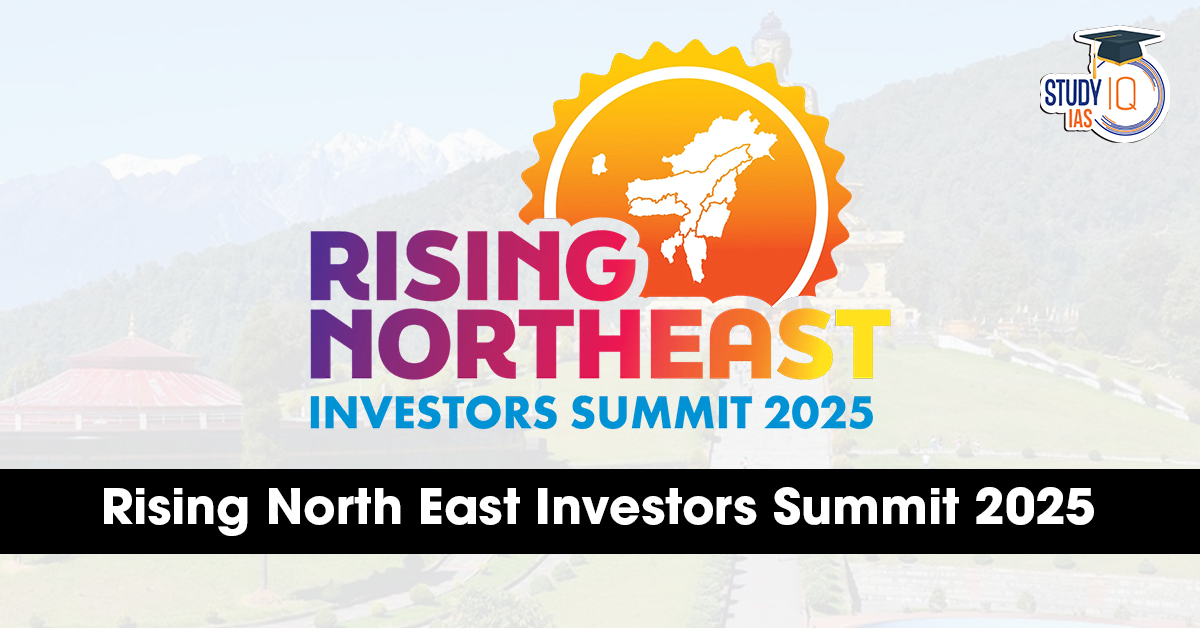Table of Contents
Context: PM Modi in the Rising North East Investors Summit 2025, highlighted the immense potential of the Northeast region and its importance in the country’s development journey.
Rising North East Investors Summit 2025
The Rising North East Investors Summit 2025, which took place on May 23–24 at Bharat Mandapam, New Delhi, was a watershed moment for India’s Northeastern Region (NER). Hosted by the Ministry of Development of North Eastern Region (MDoNER) and FICCI, the summit highlighted the enormity of investments the region has to offer, drawing international attention and making significant commitments of funds.
Focus Sectors and Strategic Initiatives
The Rising North East Investors Summit spotlighted key sectors poised for growth:
- Agro and Food Processing
- Textiles, Handloom, and Handicrafts
- Entertainment and Sports
- Education and Skill Development
- Healthcare
- IT and ITES
- Tourism and Hospitality
- Infrastructure and Logistics
- Energy
Potential of the Northeast Region
- Strategic Location: Proximity to Southeast Asian countries—shares borders with Bangladesh, Bhutan, China, and Myanmar—making it key to the Act East Policy.
- Natural Resources: Rich in forests, oil, natural gas, coal, limestone, and immense hydroelectric potential.
- Cultural Diversity: Home to over 200 ethnic communities with diverse traditions, festivals, and crafts—ideal for cultural tourism.
- Biodiversity Hotspot: Eastern Himalayas and the Indo-Burma region make it ecologically significant with rare flora and fauna.
- Agro-Climatic Diversity: Suitable for organic farming, horticulture (pineapple, orange, ginger, bamboo), and floriculture.
- Tourism Potential: Scenic landscapes (Keibul Lamjao National Park, Kaziranga National Park, Ziro Valley), adventure tourism (trekking, river rafting), and spiritual tourism (Buddhist circuits).
Reasons for Remaining Untapped
- Infrastructural Deficit: Hilly terrain, low road and rail connectivity, poor digital infrastructure.
- Insurgency and Ethnic Conflicts: Presence of multiple insurgent groups and inter-tribal tensions (e.g., Kuki-Meitei, Naga issues).
- Historical Neglect: Lack of sustained political and economic attention in post-independence India.
- Geographical Isolation: “Chicken’s Neck” (Siliguri Corridor) bottlenecks integration with the mainland.
- Bureaucratic Hurdles: Slow project clearances, land acquisition issues, and environmental clearances.
- Lack of Private Investment: Perceived as unstable, thus deterring investors despite high potential.
Major Government Initiatives for the Northeast
- Act East Policy: Upgraded version of Look East; emphasises connectivity with ASEAN through NE.
- Infrastructure Push: Sela Tunnel (Arunachal), Bhupen Hazarika Setu (Assam).
- 11,000 km of highways, new airports, rail lines, and Northeast Gas Grid (1,600 km).
- Peace Accords:
- Framework Agreement with NSCN-IM (2015)
- Bodo Peace Accord (2020)
- Bru-Reang Settlement (2020)
- AFSPA Rollback: Withdrawn from large parts of Assam, Manipur, and Nagaland.
- Investment Promotion: North East Industrial Development Scheme (NEIDS)
- Tata’s ₹27,000 crore semiconductor unit in Assam.
- Digital & Social Programs: Expansion of mobile and internet connectivity.
- Skill development under PMKVY and startups through Atal Innovation Missions.
What India Can Do to Tap These Opportunities
- Inclusive Governance: Address grievances of indigenous communities, resolve border disputes, and ensure tribal participation in policy-making.
- Improve Connectivity: Complete and expand road, rail, air, and internet infrastructure.
- Operationalise the India-Myanmar-Thailand Trilateral Highway and Kaladan Multi-Modal Transit.
- Boost Tourism: Promote eco-tourism and heritage tourism with adequate facilities and safety measures.
- Sustainable Development: Focus on environment-friendly hydro and solar power projects with local consent.
- Skill Development: Invest in skill and entrepreneurship programs tailored for youth in the region.
- Cross-border Trade: Enhance border trade points with Myanmar and Bangladesh, and align policies with Act East.
Conclusion
The Northeast is not merely a geopolitical frontier but a growth engine with immense untapped potential. However, unlocking it requires balancing development with sensitivity, resolving historical grievances, and ensuring ecological sustainability. An integrated approach aligning infrastructure, inclusion, and international linkages can make the region a pillar of India’s growth story and regional diplomacy.


 World Summit on Disaster Management (WSD...
World Summit on Disaster Management (WSD...
 Domestic Systemically Important Banks (D...
Domestic Systemically Important Banks (D...
 The Missing Link in India’s Critical M...
The Missing Link in India’s Critical M...

























